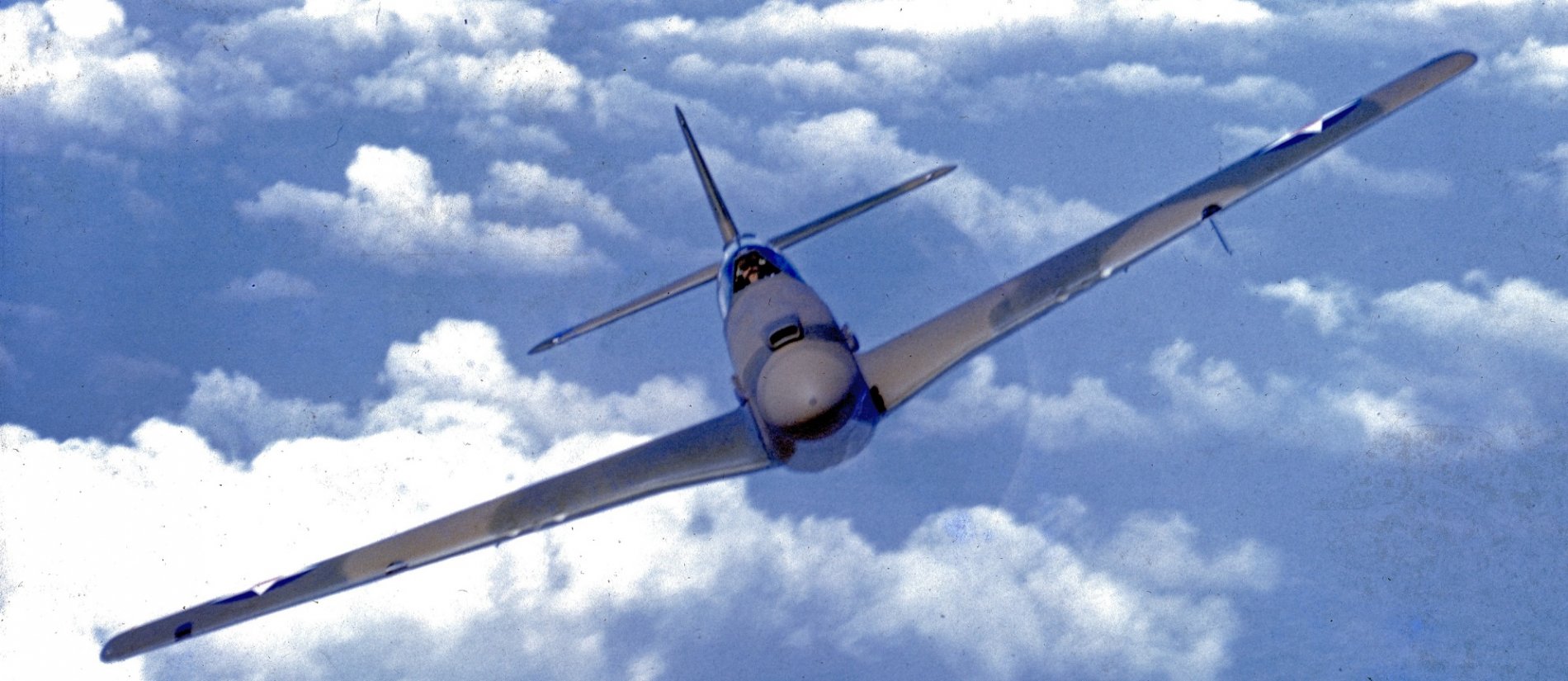Prototypes and early production (mainly for the Royal Air Force) - Allison-engined variants
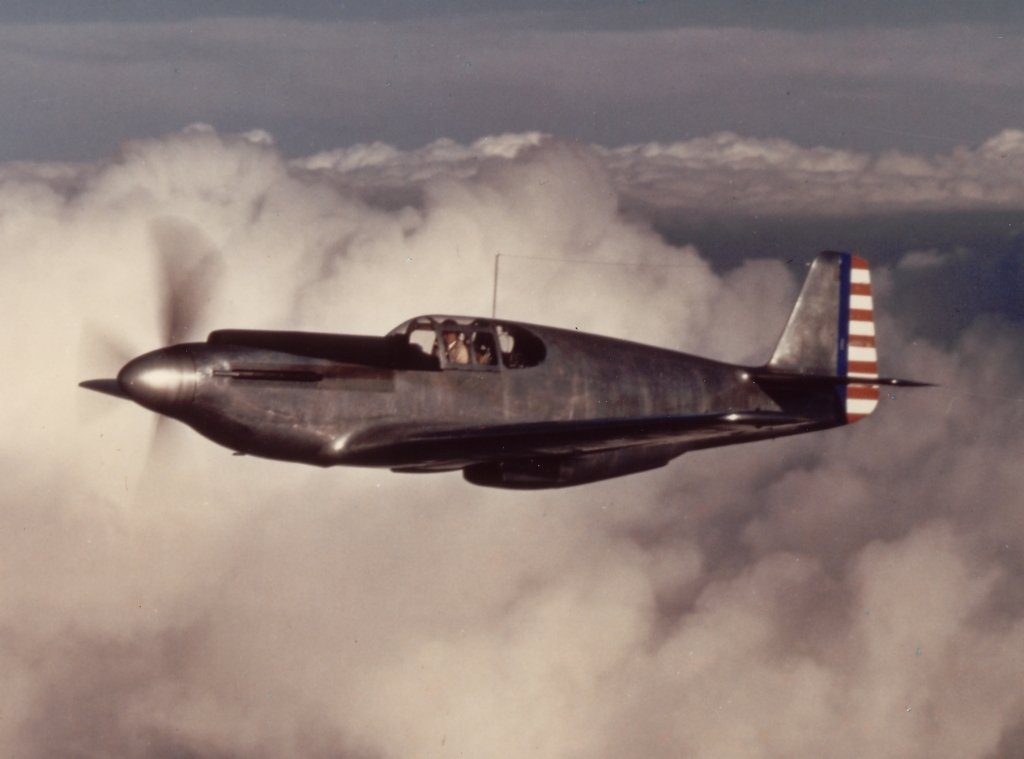
The Prototype, factory designation NA-73X, in flight.
Developed to British requirements in 1940, the North American P-51 Mustang was not only a beautiful but also a very capable fighter aircraft. Built at Inglewood, CA, the first versions were equipped with liquid-cooled Allison V-1710 engines. Most of them were delivered to the Royal Air Force (RAF) under Lend-Lease, but the U.S. Army Air Force (USAAF) retained a number of aircraft Total production of Allison-powered versions was 1’599 aircraft.
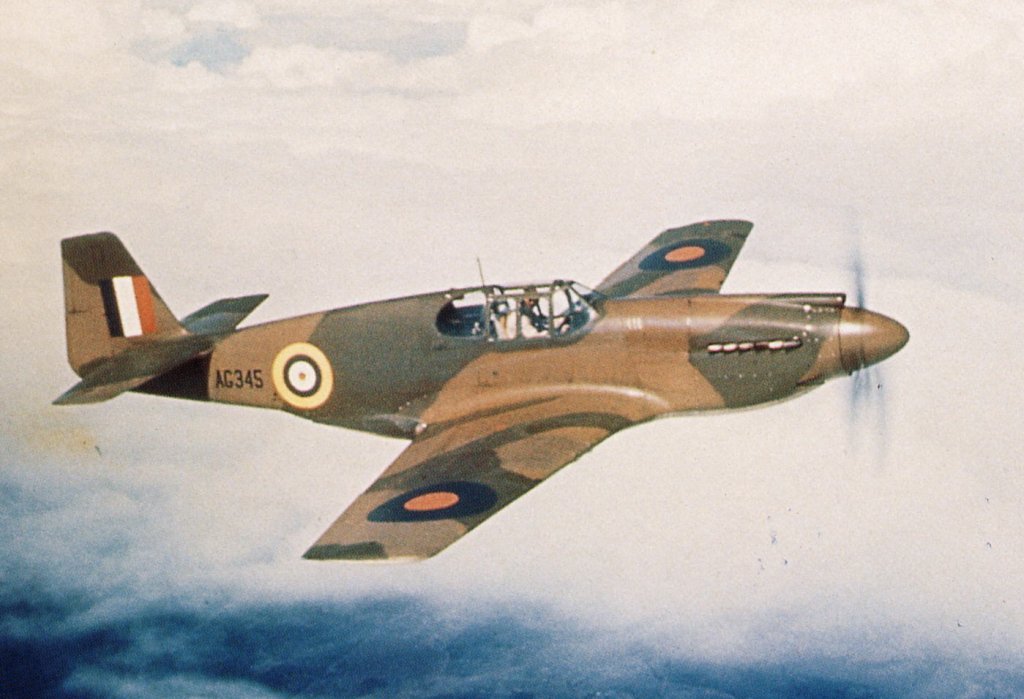
The first production Mustang I, British serial AG345, seen here during a test flight from Inglewood, CA. The first production model was designated NA-73.
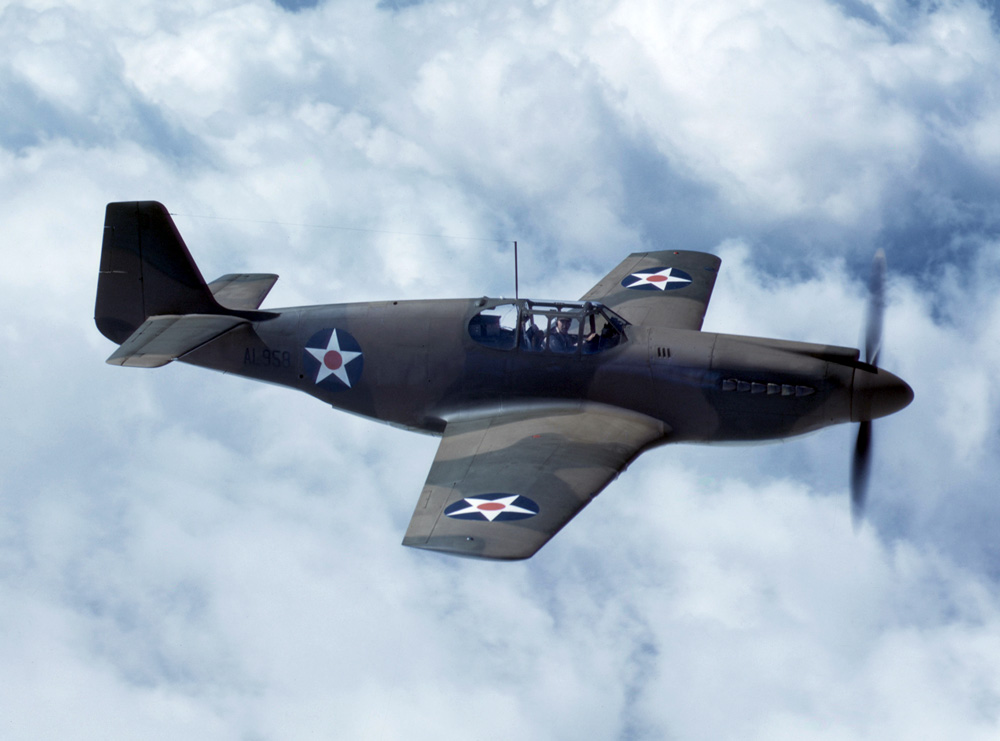
An Allison-engined Mustang I in RAF camouflage and early USAAC roundels during flight-tests over California. It is AL958, the first production model of the NA-83 production batch for the RAF.
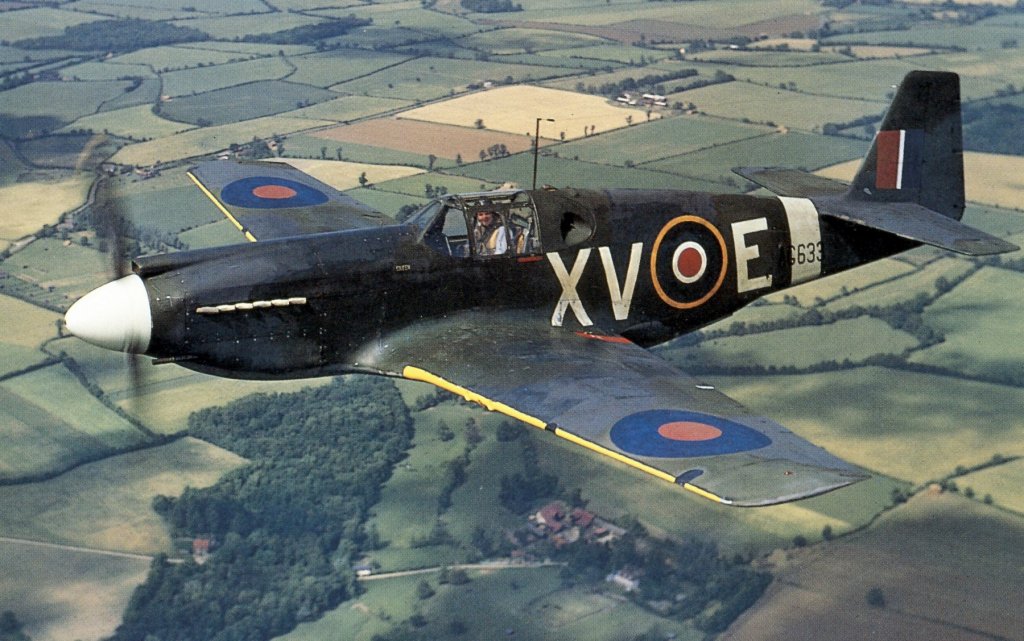
Mustang I AG633 nicknamed "Eileen" of No. 2 Sqdn RAF -> all RAF Mustang I's with AGxxx serials were model NA-73's
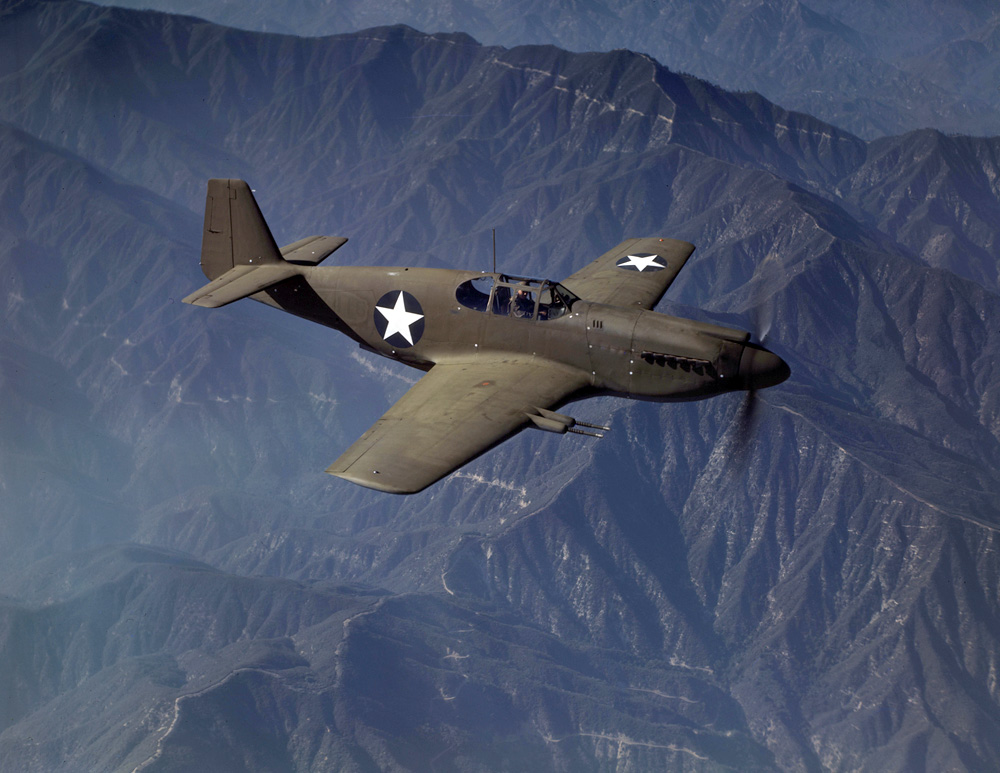
P-51-NA's were equipped with four 20mm cannons. This is a NAA publicity shot and the serial-number (41-37416) has been painted out for this purpose.
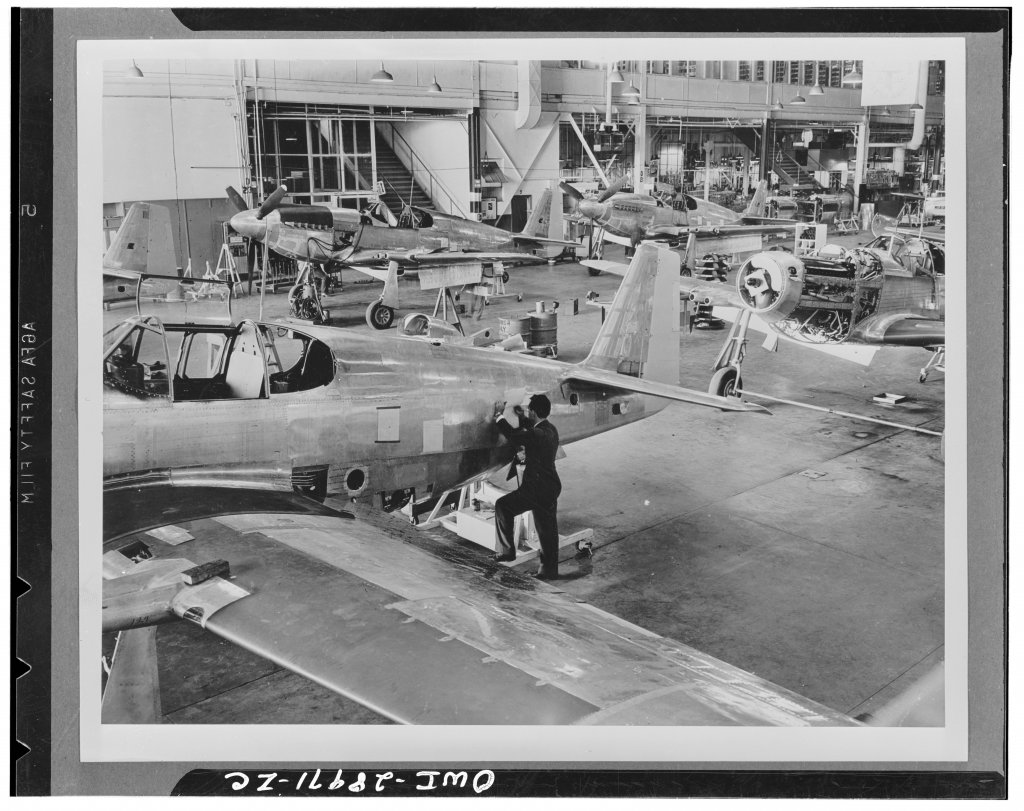
Production of P-51-NA's at the NAA Inglewood, CA, plant. Note the fairings for the 20 mm cannons protruding from the wings.
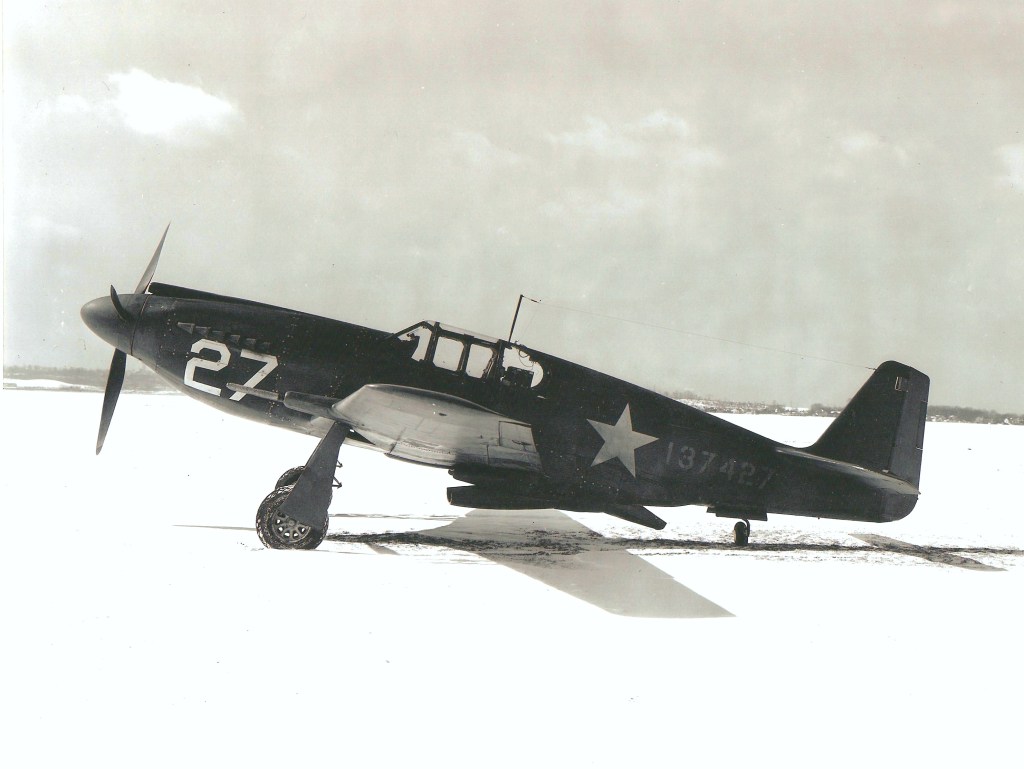
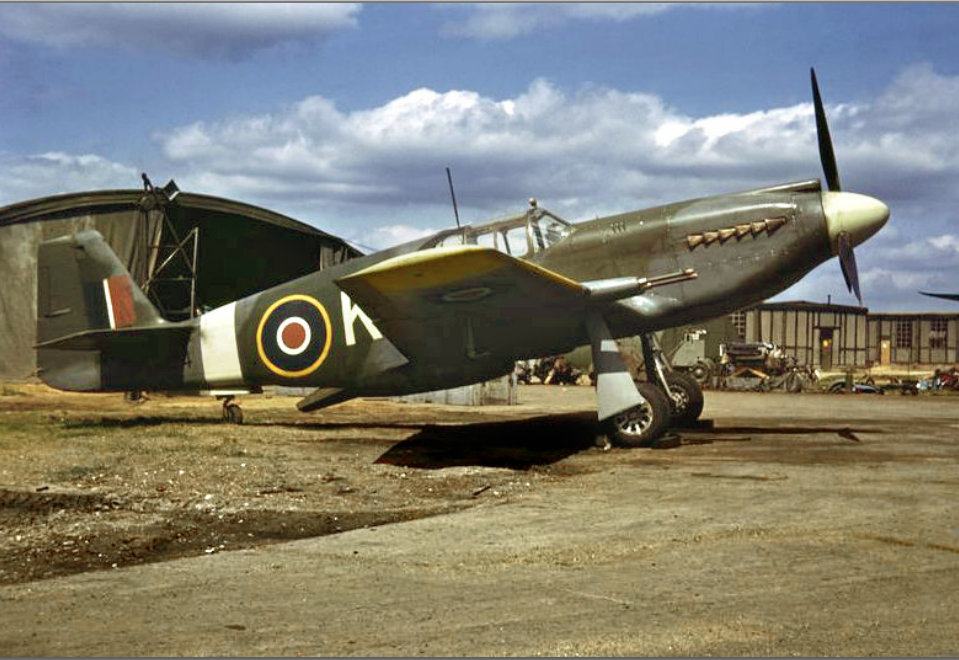
Packard Rolls-Royce Merlin engine - leading to the P-51B and P-51C
Performance limitations of this engine-type at medium and high altitude resulted in the use of the Mustang in the ground-support and reconnaissance rôles only. But after the installation of the British developed Rolls Royce Merlin engine built under license in the U.S. by Packard and designated V-1650-3 and -7 plus a four-bladed Hamilton Standard propeller, the new version P-51B (the P-51C was identical to the P-51B but built at NAA’s new plant in Dallas, TX) was to become an outstanding escort fighter plane deployed to all theatres of war. 3’738 examples of this new type were built.
This photo shows the XP-51B - it is a P-51, serial 41-37352, from the NA-91 production block, that saw the Allison engine removed and received a trial-installation of a Packard V-1650 Merlin engine. The shape of the cowlings and the exhaust configuration are different from the production models, compared to photos below (via Mark Nankivil).
Interesting photograph that offers a direct comparison between the Merlin-engined P-51B (at left) and the Allison-engined P-51A (at right).
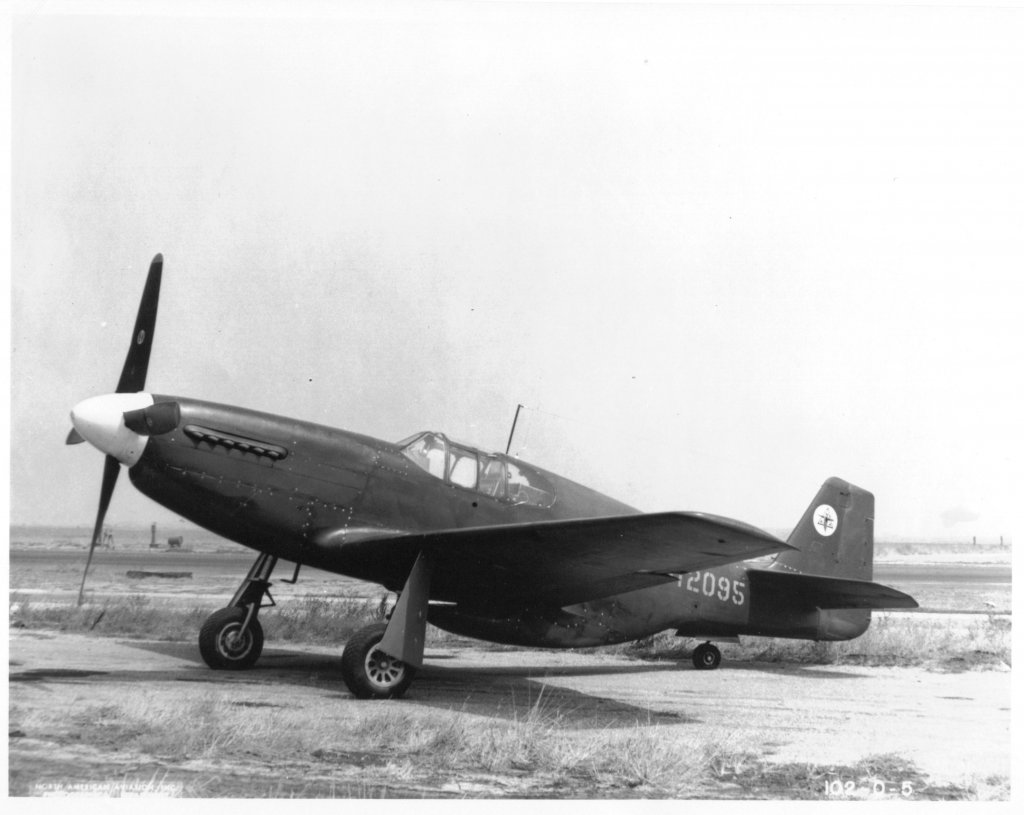
Third production P-51B-1-NA 43-12095 retained at NAA Inglewood for testing purposes - note NAA logo on the tail; this a/c later received a trial DFF (dorsal fin fillet) that later was retrofitted to operational aircraft as field-modification (see below).
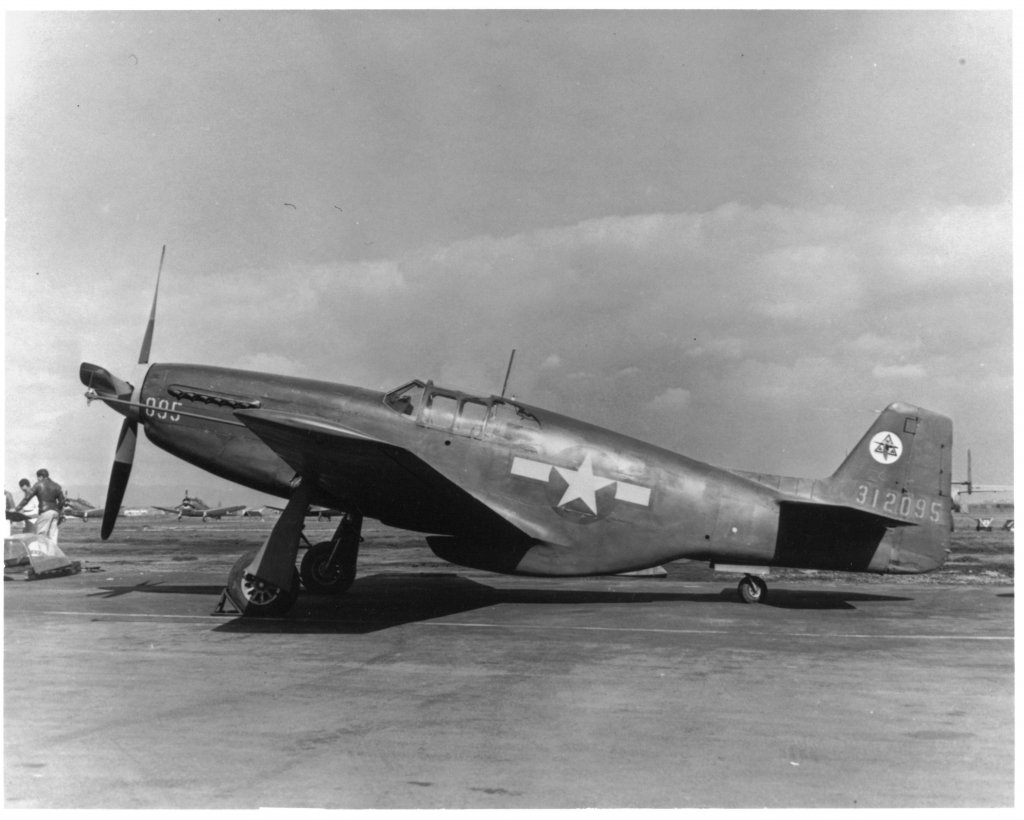
The same aircraft at a later stage - note the added DFF (dorsal fin fillet) and the relocation of the serial number plus addition of the 'last three' of the serial-number on the nose, i.e. "095".
Brand new P-51B-1-NA 43-12342 taxying at Inglewood, CA, for a test-hop...
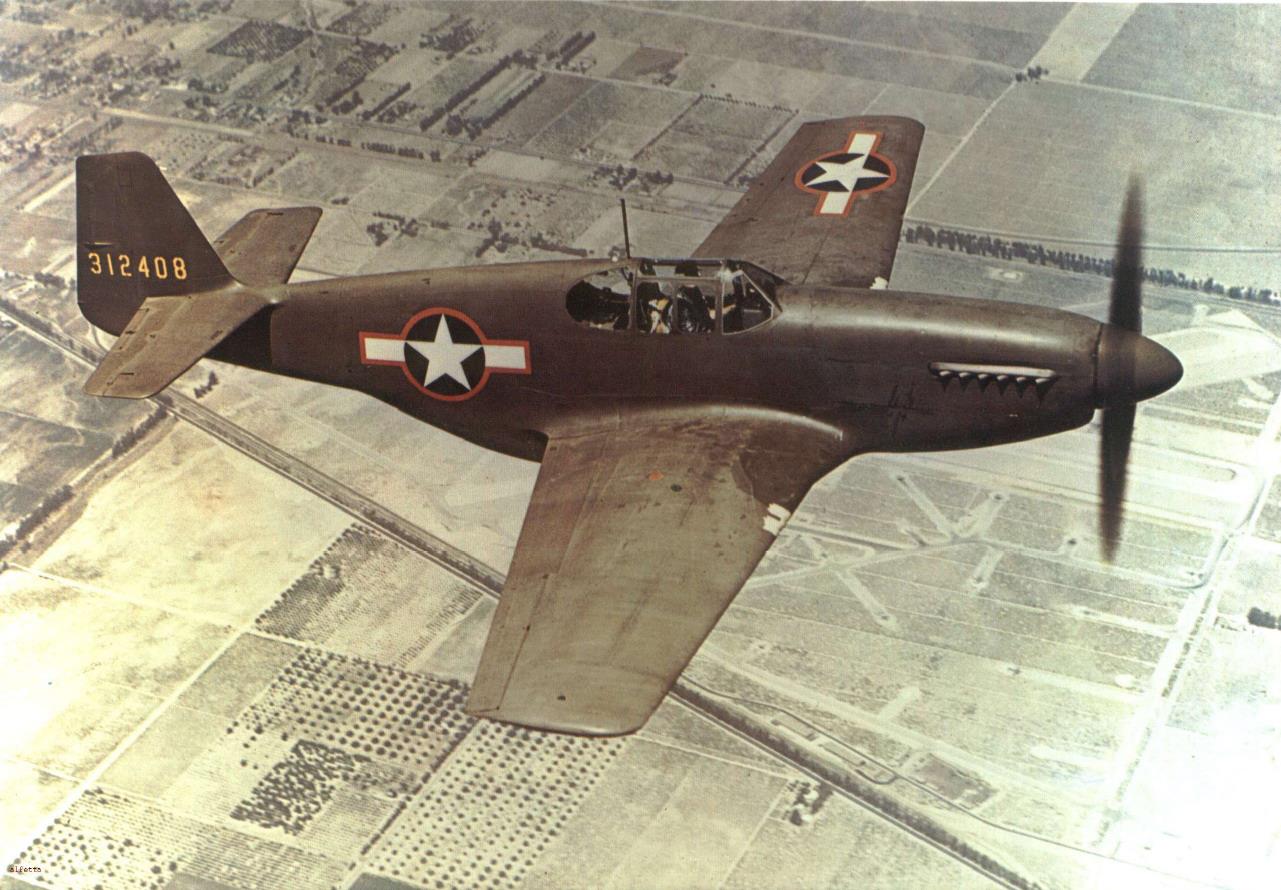
Beautiful in-flight photo of sister-ship P-51B-1-NA 43-12408 during a factory-acceptance flight - see another photo of this aircraft after deployment to the ETO and assignment to the 354th FG !
Yet another in-flight photograph of a P-51B-1-NA during a factory test. It is 43-12201 - it went to serve as trainig aircraft at Bartow Army Airfield, FL, and was s.o.c 1st January 1945.
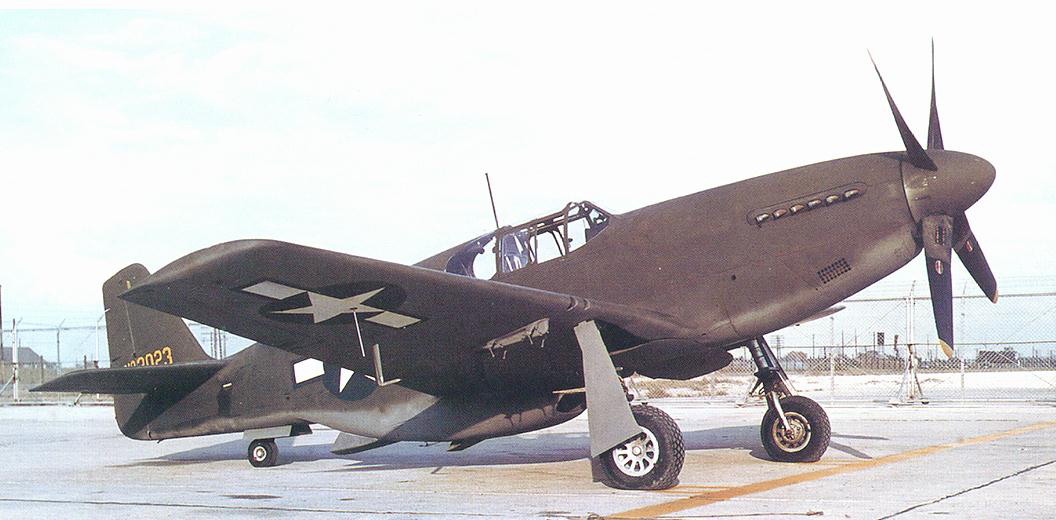
...and as comparison, a brand new P-51C-1-NT on the ramp at Dallas, TX.
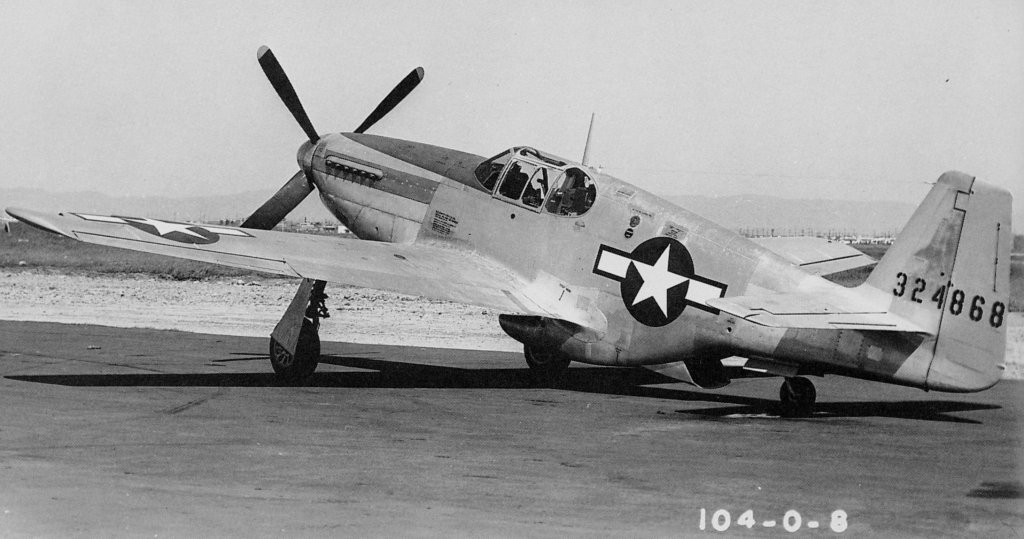
During the production of P-51B's at Inglewood and P-51C's at Dallas, the application of camouflage paint soon was dropped and the aircraft were delivered unpainted - this particular aircraft is P-51B-15-NA 43-24868.
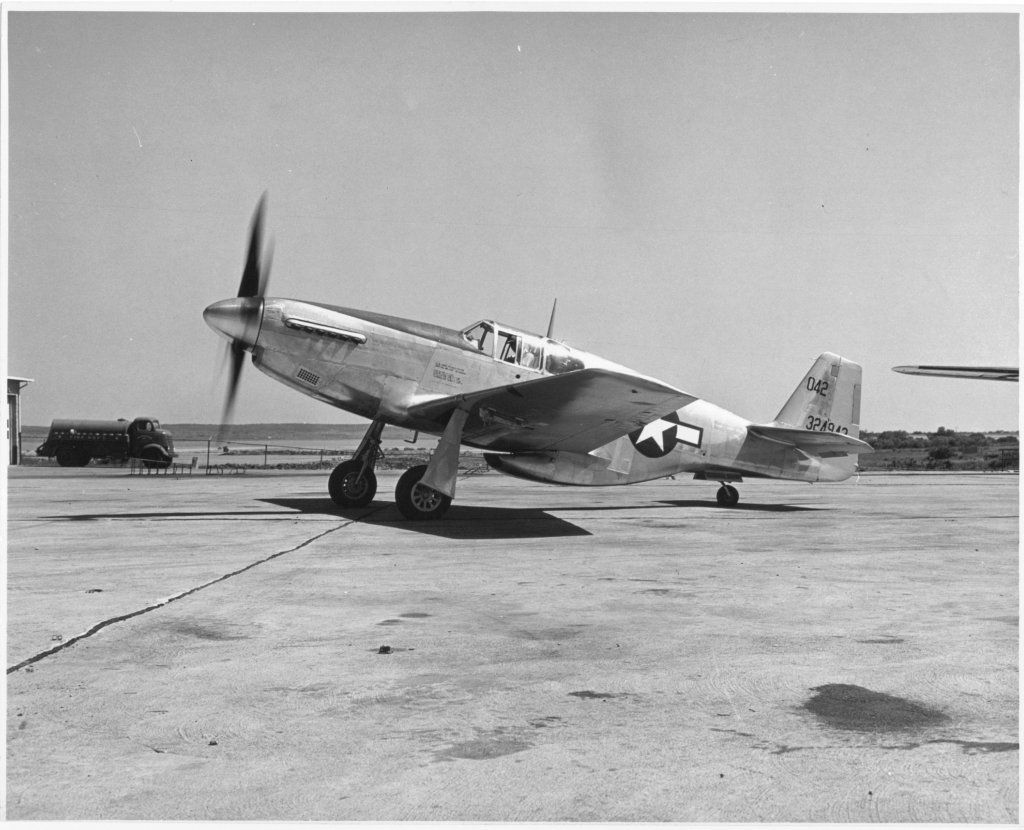
P-51C-10-NT 43-24943 built at Dallas, TX. The additional number "042" on the tail identifies this a/c as the 1'042th a/c built to model specification NA-103.
Into action
Over Europe, the first missions with this new version were flown in December 1943 from bases in England; the first operational unit was the 354th FG which earned the appropriate designation "Pioneer Mustang Group".
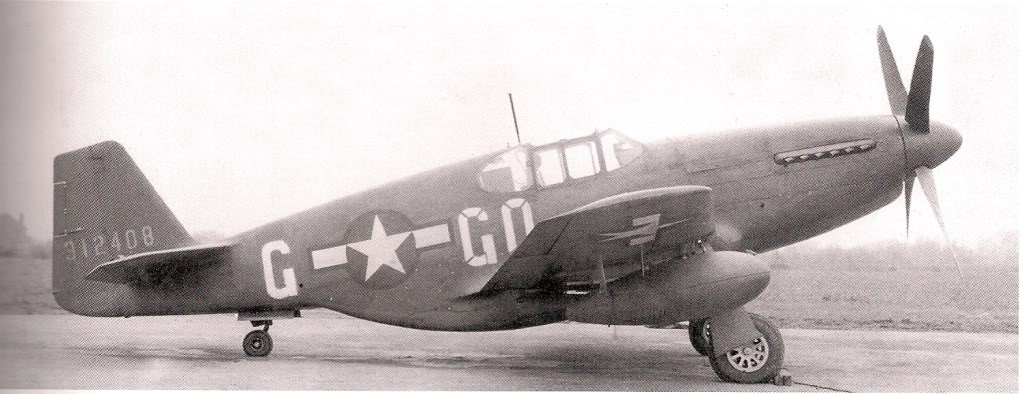
P-51B-1-NA 43-12408 assigned to the 354th FG 355th FS, code GQ-G - it is the same a/c as seen above during a factory acceptance flight. Note that the red borders to the star&bar insigna have been overpainted in blue. This is a very early photograph from late 1943, before the application of the so-called ETO recognition bands.
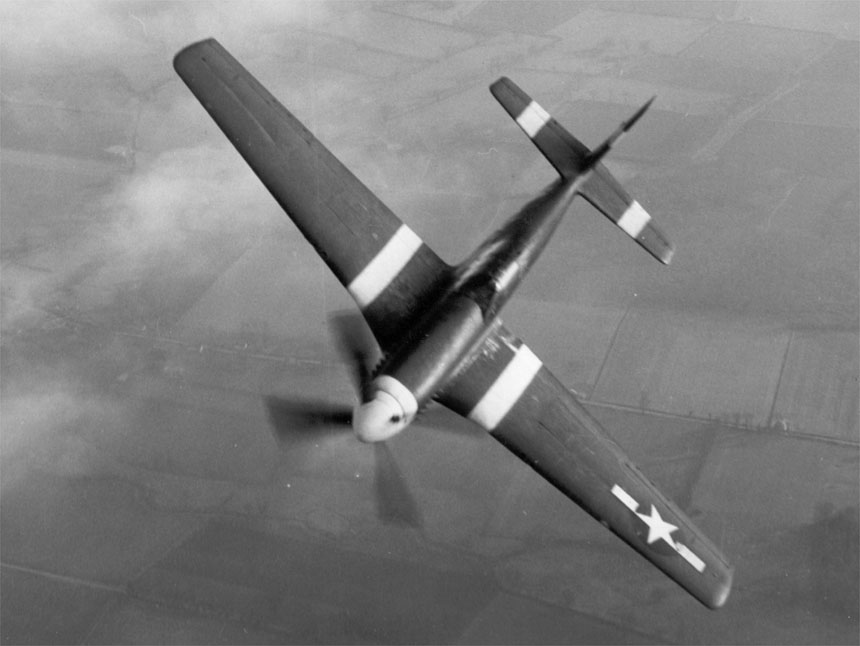
Early P-51B-1-NA of the 354th FG in flight over England, December 1943. Note the ETO recognition bands - these were introduced because during the initial missions by the Pioneer Mustang Group, it was discovered that the silhouettes of the Luftwaffe Messerschmitt BF-109's resembled closely those of the newly introduced P-51B's, and Allied (U.S. and RAF) fighter pilots not yet familiar with this new fighter type repeatedly attacked the P-51 formations.
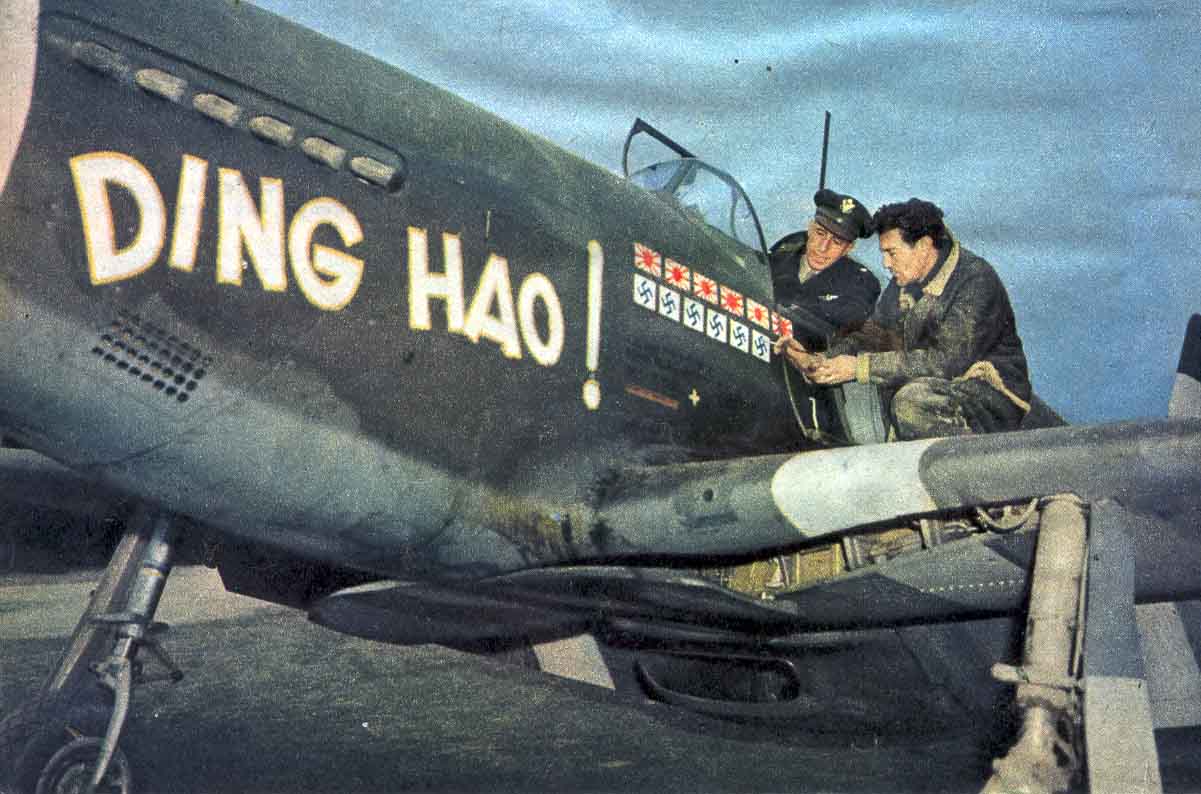
The personal mount of Maj. James H. Howard, "Ding Hao" showing markings for aerial victories achieved both against Japan while flying with the AVG ("Flying Tigers") and later with the 354th FG "Pioneer Mustang Group" against the Luftwaffe.
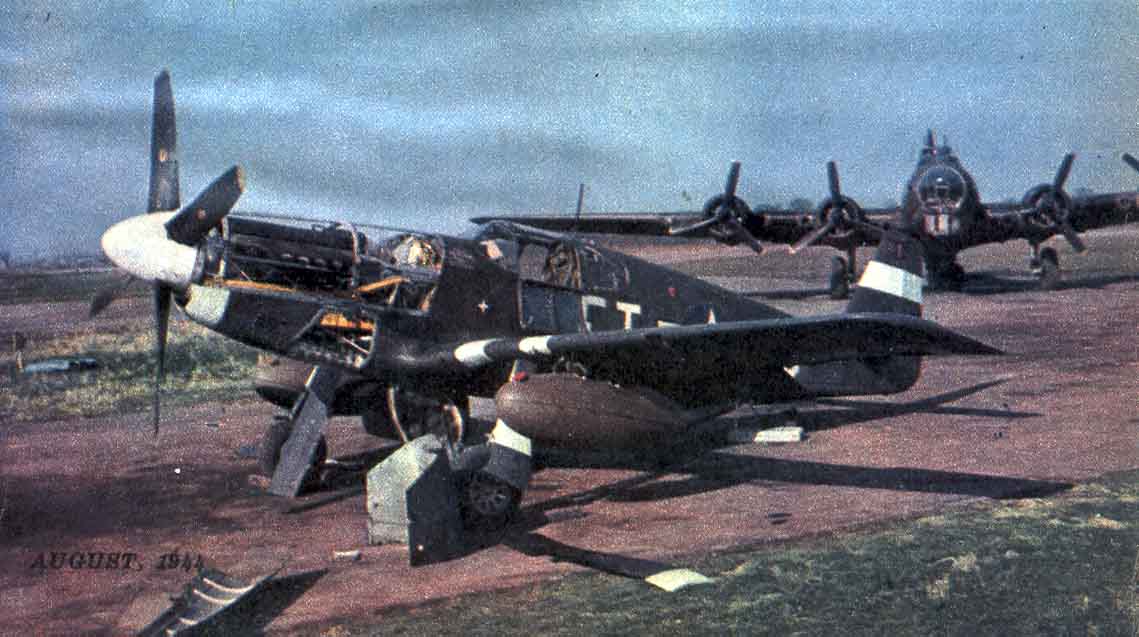
Scanned from the August 1944 issue of "Yanks", this photo is showing another early P-51B of the 353rd FS 354th FG.
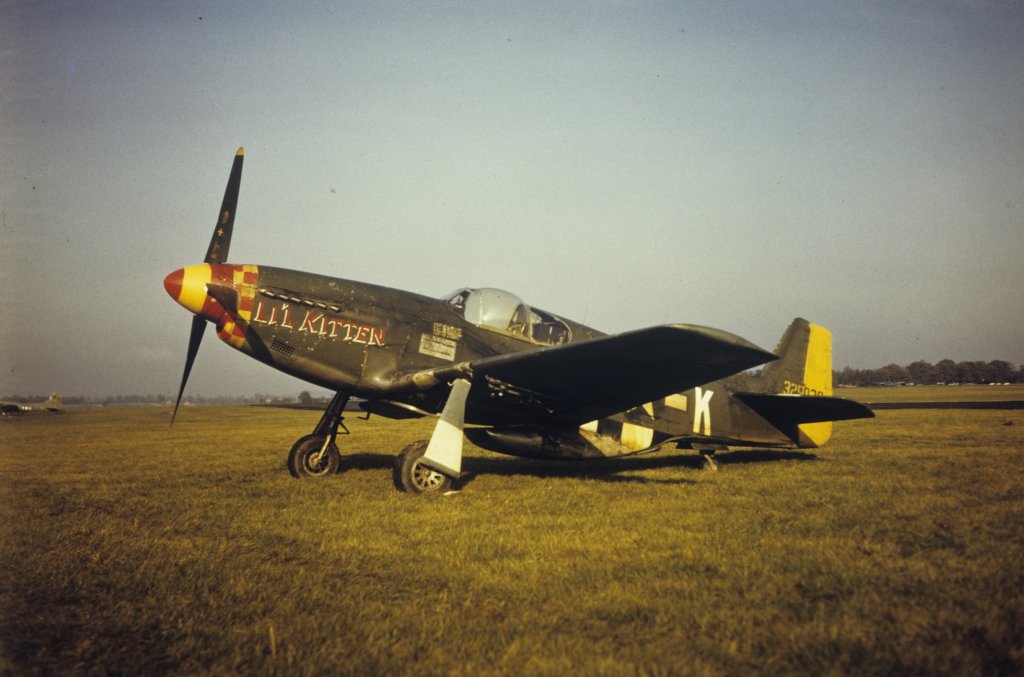
"Lil' Kitten" C5-K is a P-51C-10-NT, serial # 43-25039, of the 357th FG 364th FS. Although the USAAF received this particular aircraft unpainted, the 357th FG applied RAF Green as camouflage to all their Mustangs during Summer 1944. This aircraft has been retrofitted with a Malcolm hood (FRE 6095)
P-51B-15-NA 42-106950 of the 355th FG 354th FS coded WR-P and nicknamed "The Iowa Beaut" - this aircraft is retrofited with a Malcolm Hood - also of interest is the fact that the D-Day stripes on the upper surfaces of the wings and fuselage have been overpainted, which dates the photo to Summer 1944. This aircraft was lost in action on 11th September 1944 when shot down by flak near Marburg, Germany.
Recon ships
Besides being used as escort fighter and fighter-bomber, the P-51B and C versions also were used with Tactical Reconnaissance units of the 9th (Tactical) AAF. The aircraft used in this rôle were additionally equipped with vertical and oblique cameras, but retained their armament. Such modified aircraft received the new designation F-6C.
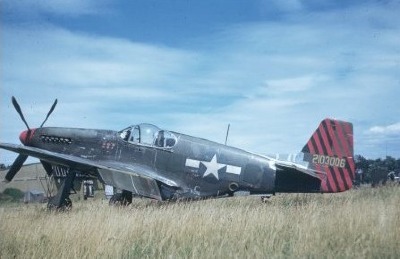
Olive-drab F-6C 42-103006 of the 111th TRS, 69th TRG. This unit arrived in France during Summer 1944, previously seeing action in the Mediterran Theatre of Operations (MTO). One camera opening can be seen below the fuselage insigna.
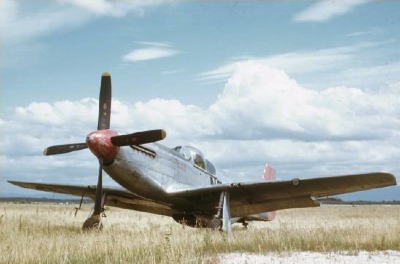
For comparison, an unpainted F-6C of the same unit (111th TRS). This example (serial 42-103397) already has the new squadron code "N5" applied. Also note that both aircraft are equipped with the British designed "Malcolm-Hood".
New Design - The P-51D and P-51K
The introduction of a teardrop shaped canopy in place of the so-far used ‘birdcage’ canopy plus provisions for three 0.50 inch Browning guns per wing (the B- and C-versions only had two guns per wing) led to the new designation P-51D for the Inglewood production and P-51K for the Dallas production (the K-type also saw the installation of an Aeroproducts propeller). After 1'500 produced K-models at Dallas, the installation of Aeroproducts propellers was discontinued, reverting to the Hamilton Standard unit. Type designation for the Dallas-built Mustangs resumed as D-models with the NT-suffix, while the Inglewood models had the NA-suffix. Of these types, over 9’602 examples were built, the first examples arriving in England during May 1944. Production continued into the 2nd half of 1945, the last models coming from the line being P-51D-30-NA's. Those aircraft converted to carry camera equipment for the Tactical Reconnaisance rôle were designated F-6D and F-6K.
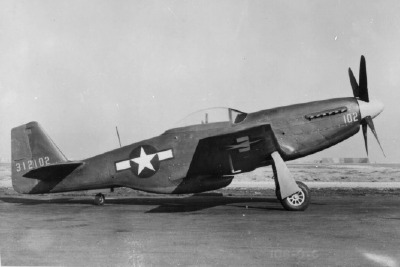
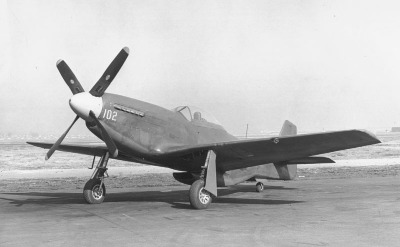
This is the prototype "XP-51D" - it is an airframe taken from the P-51B-1-NA production at Inglewood, CA (serial #43-12102) and modified with the new bubble canopy. It retained, however, the typical P-51B wing (two guns per wing and landing light in the port wing).

A colour photo of the same aircraft - although in literature repeatedly reported as "XP-51D", it appears that futher to an interview with Bob Chilton, chief test-pilot at NAA, this conversion never officially was designated as such and always was referred to as P-51B (via Laurent Boulestin).
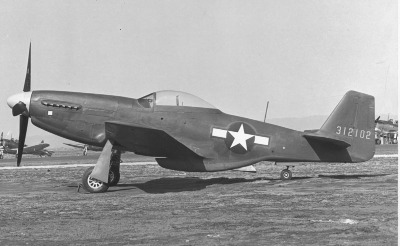
Yet another view of 43-12102 - this and the previous colour photo are early shots, while the other two show the 'last three' of the serial number, i.e. "102" on the nose (via Mark Nankivil).
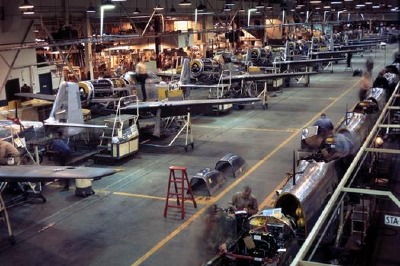
P-51D Production Line at NAA Inglewood, CA.
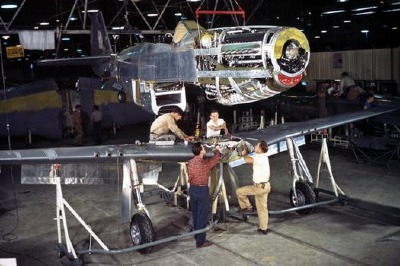
P-51D Production Line at NAA Inglewood, CA.
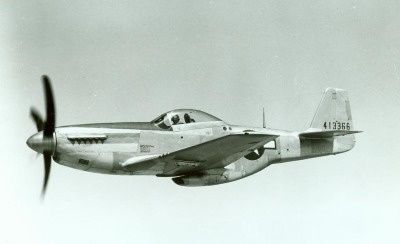
P-51D-5-NA 44-13366 fresh from production during a test-flight.
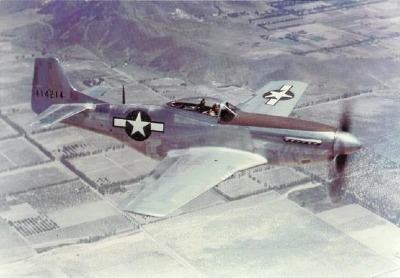
P-51D-10-NA 44-14214 during a test flight from Inglewood, CA.
Europe - ETO (European Theatre of Operations)
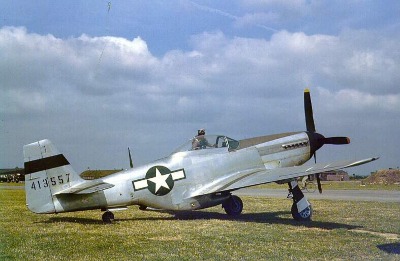
Early P-51D-5-NA (44-13557) seen here at Steeple Morden (UK), still devoid of any unit markings, early July 1944. The black nose and bands on empennage and wings were early recognition markings applied to unpainted aircraft (compare with the same markings on the camouflaged P-51B seen in the in-flight photo above). Additional information from Bill Marshall: the unmarked Mustang shown at Steeple Morden in probably July 1944 time frame was assigned to the 355th FG 357FS as OS-E as replacement aircraft right after 1st Lt. Leonard B. Fuller was KIA on 7th July 1944 in 44-13526 coded OS-E and nicknamed "Kay". 44-13557 later was assigned to the Scouting Force (Experimental) and became OS(bar)-E. The aircraft soon was transferred again, this time to the 1st Scouting Force and received code 5E-E and nickname "Easy Does It".
In Europe (ETO), all but one Fighter Group of the England-based 8th USAAF eventually were equipped with this type, plus a number of fighter- and reconnaissance-units of the 9th (Tactical) USAAF (deployed to the Continent post D-Day). Each unit adopted distinctive and easily recognizable unit markings applied to spinners and cowlings of their Mustangs. A few examples are shown below.

Seen here is P-51D-10-NA 44-14798 of the famous 'Yoxford Boxs' 357th FG 362nd FS from the 8th USAAF, coded G4-V and nicknamed 'Butch Baby'. This aircraft survived the hostilities but was scrapped in June 1945 after a landing accident at Leiston (UK). This is another example of an originally unpainted Mustang being camouflaged with RAF Green during summer 1944.
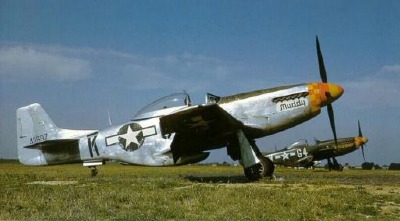
Again from the 357th FG 362nd FS, this is a Dallas-built P-51K-5-NT, serial 44-11697, coded G4-K(bar) and nicknamed "Muddy". This aircraft also survived the war but was scrapped in England in December 1945. The addition of a bar below or above the individual aircraft letter was done when two aircraft with the same code-letter were assigned to a Squadron at the same time.
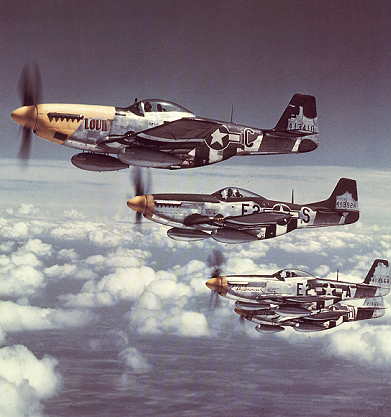
Famous photograph named 'Bottisham Four' showing Mustangs from the 361st FG 375th FS in Summer 1944. Bottisham was the base of the 361st FG. The nearest aircraft is P-51D-5-NA 44-13410 E2-C 'Lou IV'. Of note is the 'mixed bag' of versions and markings in this photo; the 2nd aircraft (E2-S, serial # 44-13926) already is equipped with the fin-fillet, the furthest a/c is a P-51B-15-NA (E2-H, serial # 42-106811). The yellow colour on the noses also shows different patterns.
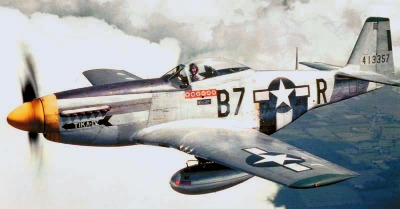
Another 'Yellow Noser" - P-51D-5-NA 44-13357 B7-R "Tika IV" of the 361st FG 374th FS assigned to Lt. Vernon R. Richards. It was lost with another pilot in an accident near Little Walden, England, on 16th November 1944.
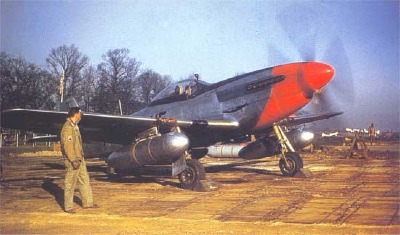
This is an example of the 4th FG 'Debden Eagles' ready for a mission early in 1945. It is P-51D-15-NA 44-15375 VF-T of the 336th FS.
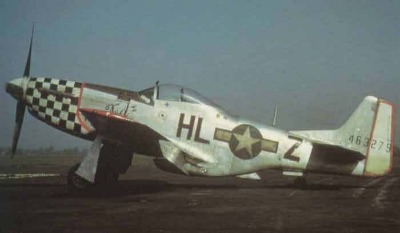
This is P-51D-20-NA 44-63279 of the Duxford-based 78th FG 83rd FS, coded HL-Z and nicknamed 'Mr. Ted III'. This aircraft was sold to Sweden in 1948 and used there as spare-parts source.
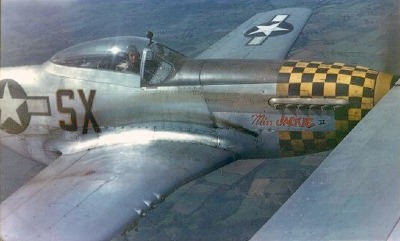
P-51D-15-NA 44-14963 SX-D "Miss Jackie II" of the 353rd FG 352nd FS in close formation during an escort mission.
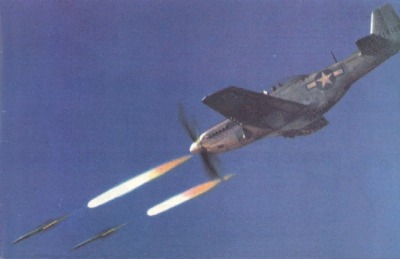
During production of the D-25-NA model at Inglewood, CA, a new "zero-lenght" rocket launcher system was introduced to give the aircraft more fire-power against ground-targets. This impressive photograph above shows P-51D-10-NA 44-14105 which was used for testing the new equipment at Wright Field, OH, Summer 1944. - This version (P-51D-25-NA) arrived in Europe only during Spring 1945 and the rocket-equipment therefore only saw limited in this Theatre of Operations during World War 2.
"Hacks" and two-seat conversions
With the arrival of the new D- and K-models, some aircraft of the earlier 'birdcage' versions were transferred to Training and Replacement units in the UK (ofter referred to as OTU [operational training unit - a British term]), but some were also kept as so-called 'Squadron-hacks', i.e. aircraft declared unfit for combat and therefore used for local navigation training missions, familiarisation flights by newly arrived replacement-pilots, and other duties. Usually such aircraft were marked with "WW" on the tail, an abbreviation for "war-weary", to make sure that they were not used for combat-missions anymore. Quite a number of these planes were converted to two-seaters, by removing the fuselage tank, relocating the radio equipment and installing a second seat behind the pilot's seat. These conversions sometimes were also used to give some lucky groundcrew-men the experience of a flight in a fighter plane. After VE-Day, some Mustangs were adorned with colourful schemes:
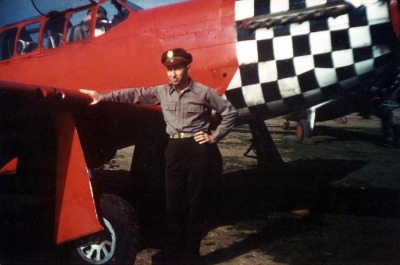
This is P-51B-15-NT 42-106826 of the 78th Fighter Group at Duxford.
Recon ships
After the Invasion of France (D-Day) on 6th June 1944, there was an increased need for reconnaissance capabilities to cover the advance of the Armies on the ground. In order to get much needed photographs and intelligence reports, a number of P-51D fighters were field-converted to F-6D Tac Recon aircraft, by adding vertical and oblique cameras in the fuselage, but retaining full armament.
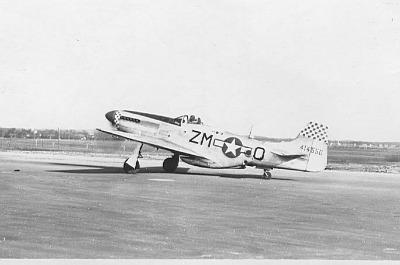
Seen here in France during Fall 1944 is F-6D-10-NA 44-14550 ZM-O of the 10th TRG 12th TRS taxying out for another Tac Recon mission.
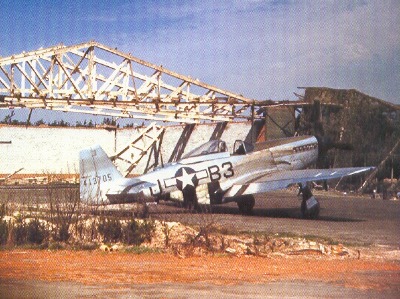
Another field converted F-6D-5-NA, serial # 44-13705, seen here at the former Luftwaffe base Venlo in The Netherlands. The code B3-U identifies this aircraft as assigned to the 363rd TRG 381st TRS (Hub Groeneveld).
Europe - MTO (Mediterranean Theatre of Operations)
The 15th USAAF (based in Italy - MTO) saw the use of the Mustang as escort fighter with four units being equipped; one of the units was the 332nd FG, an unit made up of coloured personnel only and called 'The Tuskeege Airmen', but better known as 'Red Tail Angels' to the bomber crews, because of the unique aircraft markings and the fact, that this unit reportedly never lost a single bomber-plane they were escorting to enemy fighters throughout all their missions !
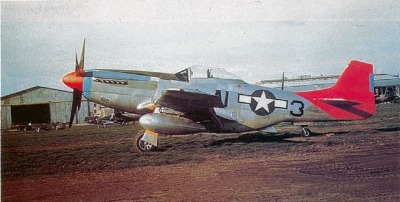
A fine example of a P-51D belonging to the 332nd Fighter Group.
Other than the Fighter Groups of the 8th and 9th USAAF with their different nose-colours, all Fighter Groups of the 15th USAAF had red noses, but different colours applied to the empennage.
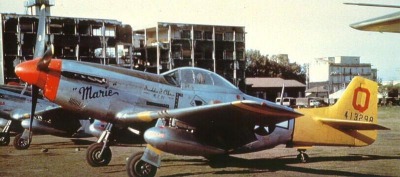
Another unit of the 15th USAAF was the 52nd FG, represented here by P-51D-5-NA 44-13298 QP-Q 'Marie' of the 2nd FS. An aircraft from this Fighter Group was interned in Switzerland in February 1945 (see article under 'History').
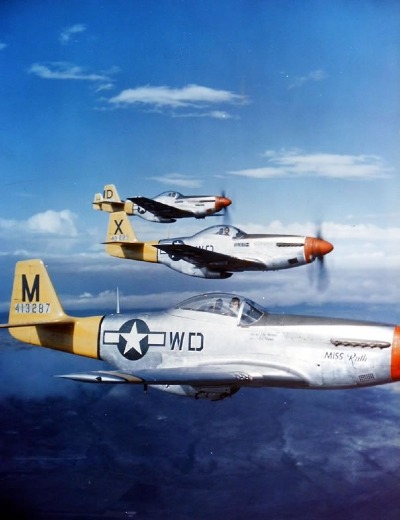
This beautiful photograph shows a flight of four early P-51D-5-NA's from the 52nd FG 4th FS - nearest a/c is 44-13287 WD-M "Miss Ruth", with 44-13289 WD-X behind - both survived the war and were salvaged in September 1945. Third a/c is 44-13263 WD-D "Jo-Baby", and fourth a/c is 44-13485 WD-H, both lost on 11th November 1944.
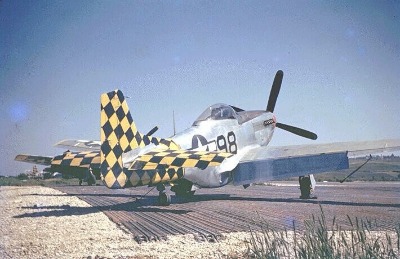
The 325th FG was called 'The Checkertail Clan' with a/c #98 showing the distinctive markings at Mondolfo in March 1945 (A.I. Christo).
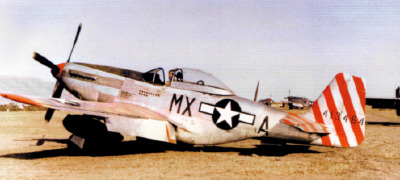
The 31st FG was recognizable from their red 'Candy' stripes on the Mustang's tail unit. Seen here is P-51D-5-NA 44-13464 MX-A from the 307th FS during Summer 1944.
Far East
In the Pacific (PTO) and the China-Burma-India (CBI) theatres, the Mustang provided valuable service in long-range escort duties and reconnaissance missions, too.
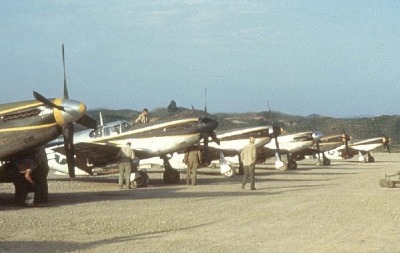
Line-up of F-6C's (P-51B and C's converted for reconnaissance duties) of the 23rd FG 118th TRS in China, 1944. (Bob Bourlier)
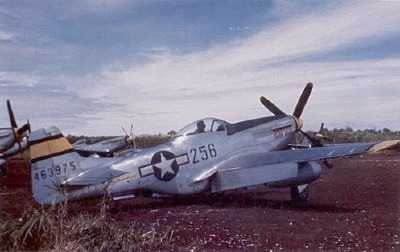
P-51D-20-NA 44-63975 '256' of the 21st FG 46th FS based at Iwo Jima and used for escorting the B-29 heavy bombers in their missions to Japan.
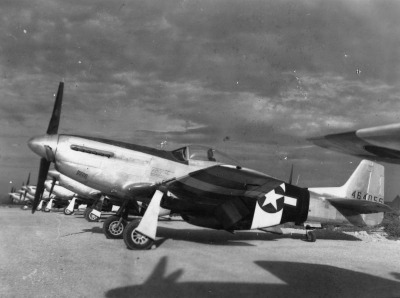
P-51D-20-NA 44-64056 and a line of other newly deployed sister aircraft seen here at Laverton, shortly after VJ-Day. Many of these new aircraft were scrapped on spot, arriving just too late to see action in the PTO and then being declared as surplus.
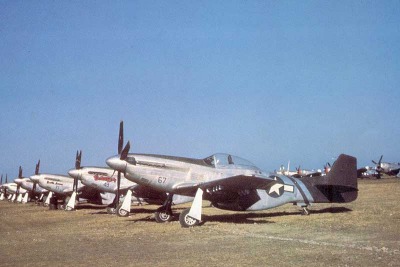
Line-up of late P-51D's of the 23rd FG 75th FS in China during Summer 1945. The aircraft in the background are P-47D Thunderbolts.
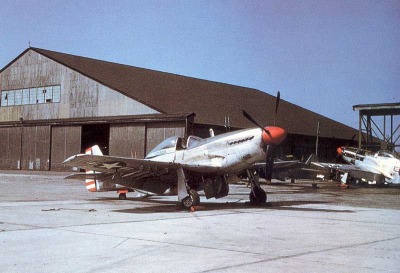
Occupation in Japan: Seen here are P-51D's of the 348th FG in Japan shortly after VJ-Day.
Z.I. (Zone of Interior) - Stateside training
All models of the P-51 family were also used in various stateside training units to train fighter pilots before they were assigned to frontline units.
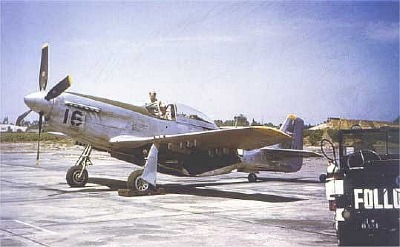
P-51D of a stateside training unit in 1945.
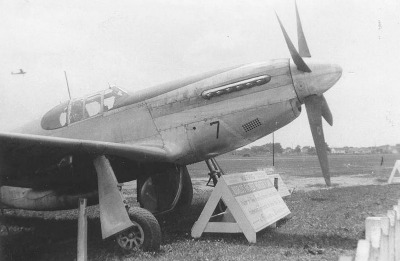
P-51C-5-NT 42-103420 on static display during the Army Air Show at the Detroit Airport on 25th June 1944.
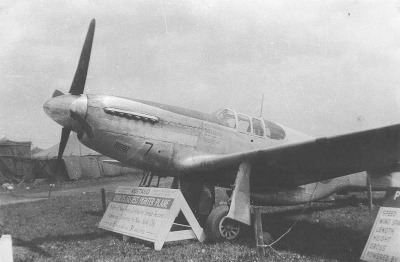
another view of P-51C-5-NT 42-103420 on static display during the Army Air Show at the Detroit Airport on 25th June 1944.
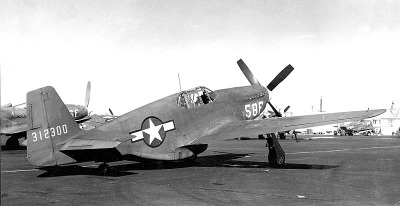
P-51B-1-NA 43-12300 used as training aircraft by the 118th TRS at Meridian, MS, while undergoing low level Tac Recon training in 1943. This unit later moved to China where it was attached to the famous 23rd Fighter Group.
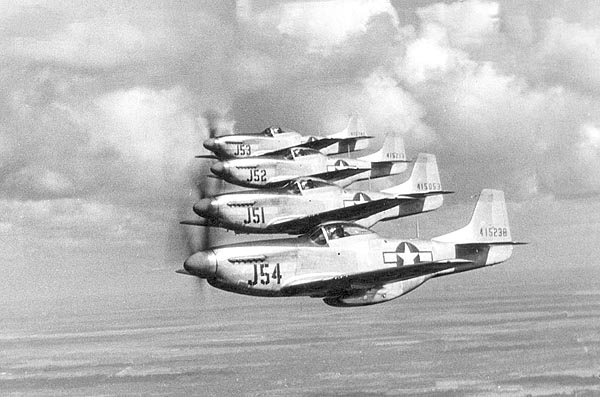
A flight of four P-51D-15-NA's over Sarasota, FL, in 1945.
Foreign operators and postwar use
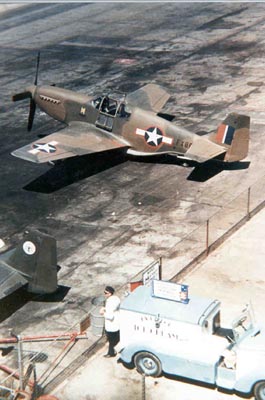
The RAF took delivery of over 1’600 P-51B/C’s (designated Mustang III's) and D/K’s (designated Mustang IV's) under Lend-Lease-Contracts. Seen at left: An early P-51B-1-NA at the Inglewood factory with a mixture of US and British markings. The camouflage is typical for the first Merlin-engined Mustangs delivered to the RAF under the designation Mustang III.
After World War 2, the Mustang saw extensive use with units attached to the Occupational Forces in Germany and Japan; but the introduction of modern jet-fighters gradually ended the use of the Mustang as front-line equipment. While in the U.S., many training units and the Air National Guard received this type and used them well into the 50’s, the planes left in the former war zones were either scrapped, stored or sold to friendly nations. Those scrapped were mostly the B-/C-models and high-time D-models of the D-5, D-10 and D-15 production batches, as well as most K-models (except those equipped with camera installation for reconnaissance duties).
The European countries to receive Mustangs in the post-WW2 era were France, Sweden, Italy and Switzerland. For more information on European Mustangs, click here.
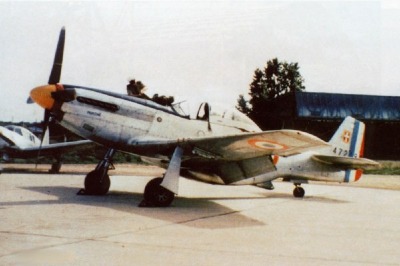
French Air Force P-51D-20-NA 44-72193 of GR II/33. This aircraft is rather interesting - it is a two seat conversion with elongated and strengthened canopy.
Mustangs from 'Down Under'
200 Mustangs similar to the P-51D version were produced in Australia by CAC under license between June 1945 and August 1951. Some saw use during the Korean War (see below). For more information click here.
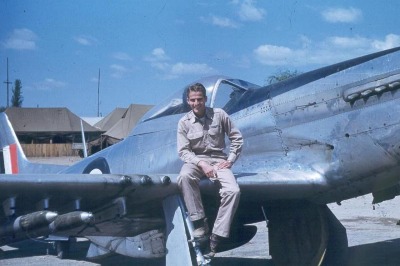
A license-built CAC Mustang of No. 77 Sqdn in Korea 1950 (John T. Gordon)
War again !
During the Korean War, 1950-1953, the Mustang again saw extensive use, mainly in the fighter-bomber and reconnaissance rôle. Operators of this type during the first three years of the conflict were the USAF (U.S. Air Force), RAAF (Royal Australian Air Force), SAAF (South African Air Force) and the ROKAF (Republic Of Korea Air Force).
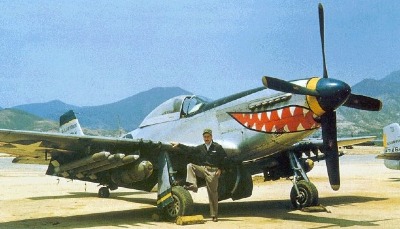
F-51D-25-NA Mustang of the 18th Fighter Bomber Group in Korea.
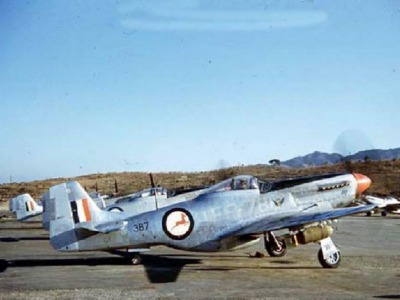
F-51D-30-NA '387' of No. 2 Sqdn 'Flying Cheetahs', SAAF. This is former USAF 44-74786 - this particular aircraft was returned to the USAF after the 'Flying Cheetahs' had converted to North Ameican F-86 Jet Fighters. The Mustang, however, was passed on to the ROKAF in 1954 and was finally scrapped in 1957 (Don Eaton).
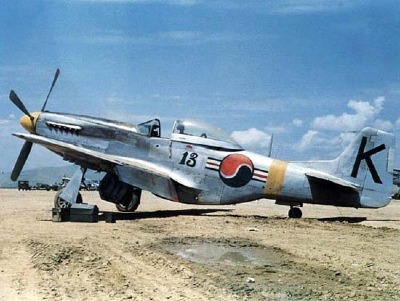
An example of a former USAF F-51D-25-NA Mustang in service with the ROKAF.
For more photographs and information, click here.
Mustangs forever !
During the late 40's and throughout the 50's, the P-51D Mustang was widely used for pilot training in the USAF and also equipped many units of the newly formed Air National Guard. Also see here.
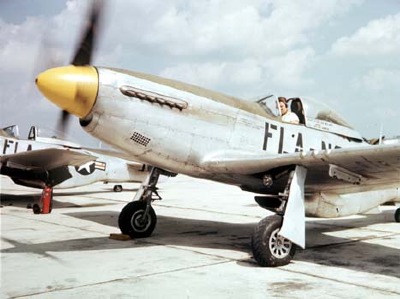
P-51D-25-NA's of the Florida Air National Guard.
Worldwide use
Also starting in the early 1950's many other countries all over the world (in addition to the European countries listed above) purchased the Mustang as affordable aircraft that had a lot of punch but was 'maintenance-freindly'. Amazingly the last military operated examples (Dominican Republic) were retired in 1984 only !
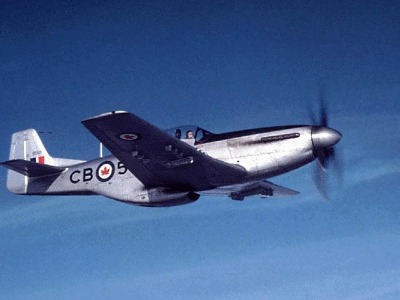
A RCAF P-51D-25-NA, serial 9569 (ex 44-73216) of Trenton Station Flight, coded CB-569 in flight.
Canada received 130 Mustangs in 1950. This type was used to equip the RCAF's auxiliary units and various station flights for many years. When the Canadian Mustangs were withdrawn from use during the late 50's, many Latin American countries purchased the bigger part of the surviving examples.
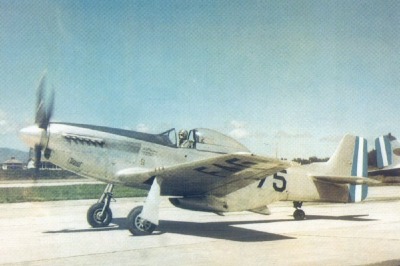
Representing the numerous Latin American users of the P-51D-30-NA Mustang is here an example of the Fuerza Aerea Guatemalteca, FAG-375. This is former USAAF 44-74854 which had seen service with the RCAF, serialled 9272, before being sold as surplus in 1959 and adopting civil registration before going south to Guatemala during 1962 (via C.Fowles).
More Latin American & Caribbean Mustangs you will find here.
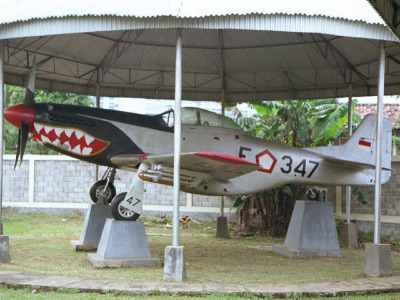
The Indonesian Air Force (AURI) was another user of the Mustang for many years - seen here is F-347 as preserved today. The initial contingent of Indonesian Mustangs was from the NEIAF (Netherlands East Indies Air Force), but a number of additional aircraft were acquired from various sources. The former identity of this particular Mustang is not clearly verified yet (Marc Koelich).
More Asian Mustangs are to be found here.
With the end of World War 2, hundreds of airplanes suddenly were no longer used and went into storage. Civilians (mainly former Air Force and Navy pilots) started to purchase such aircraft at scrap value and initially used them for trans-continental air racing and pleasure. Over the decades and with additional airworthy Mustangs being surplused by various Air Forces around the world, this type became one of the most popular Warbirds ever.
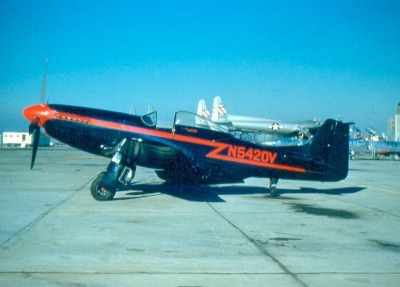
An example of an early civil Mustang, P-51D-25-NA, former 44-74202, with civil registration N5420V seen here at Oakland Airport in December 1958.
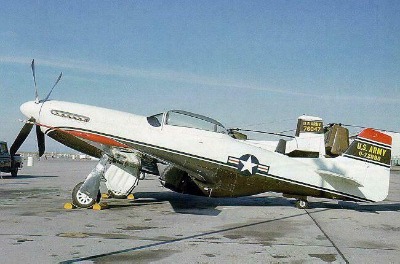
P-51D-25-NA 44-72990 was modified by Aero Sports at Chino, CA, to a two-seat variant for the U.S. Army as Chase Plane for use in the Lockheed AH-56A Cheyenne armed helicopter program during the late 1960's, early 1970's.
Variants
A later variant of the Mustang was the P-51H, light-weight version, which came too late for any action in World War 2. Only 555 examples were built, and used by the USAF and the USANG during the late 40's and early 50's. Although this version looked very similar to the P-51D/K, it was a new design and only few parts were interchangeable between the models. The engine used in this type was the Packard Merlin V-1650-9.
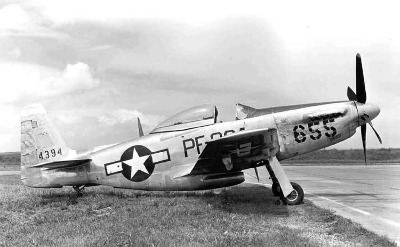
P-51H-5-NA 44-64394 of the USAF (William T. Larkins).
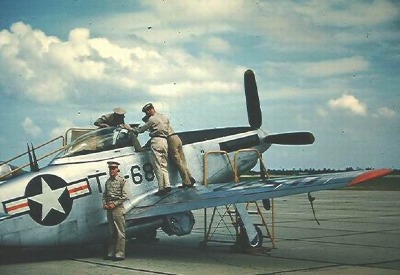
A TF-51H-10-NA of the USAF during the early 50's.
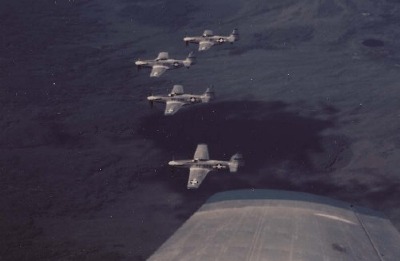
"Finger Four" Formation of P-51H's of the 82nd FG 62nd FS over Alaska during 1945 (Alfred B. Styrsky).
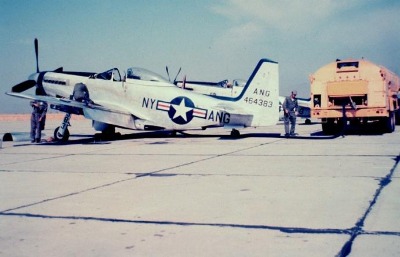
F-51H 44-64383 of the 139th FS New York Air National Guard at Schenectady Airfield, NY.
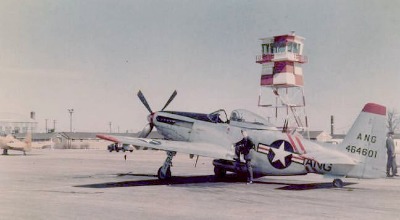
F-51H 44-64601, 158th FS GA ANG at Malden AFB, Missouri, late 1952.
-> more F-51H photos can be found in the USAF/USANG section here.
"Two times 51 equals 82"....
Another variant was the unique Twin Mustang, type designation P-82, with two fuselages being combined by a centre wing section. Although the fuselages looked similar to the P-51H, again their design was fairly different. Destined for Very Long Range Escort Missions, this type came too late for action during WW 2 but saw extensive use during the Korean War 1950 - 1953 as Night Fighter aircraft. Early production aircraft used Packard Merlin V-1650 variants, but main the production incorporated Allison V-1710 engines.
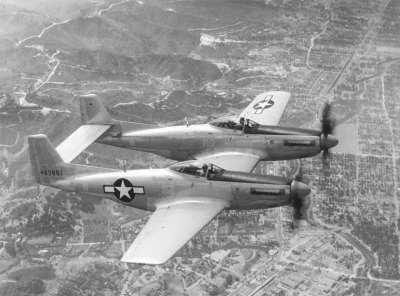
Second prototype XP-82 (44-83887) during tests.
First production P-82E 46-255 on display. This photograph was taken at Muroc Army Air base in June 1947 (David A. Anderton via Ron Picciani).
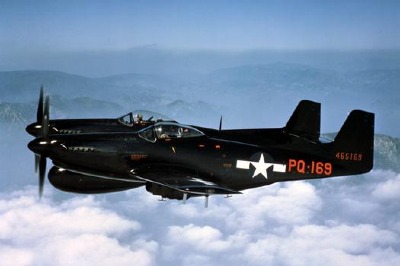
Great in-flight photograph showing the conversion of the 10th production P-82B to a P-82C night fighter.
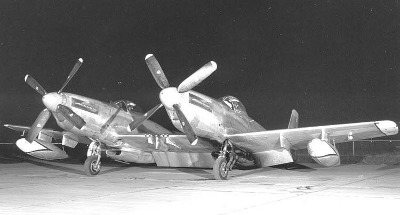
Beautiful night shot of a P-82E equipped with wing-tanks.(photo courtesy of William T. Larkins)
I would like to receive your comments an questions. Please use the guestbook or send your inputs and queries by e-mail. Contact.

You are welcome to link my site - please feel free to use this banner. Prior notification is very appreciated. Thank you.
© Martin Kyburz / Swiss Mustangs 2003 - 2020

